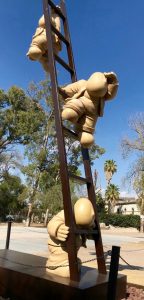When it’s my turn to receive the coronavirus vaccine here in San Miguel de Allende, Mexico, it may be that the shot I get is named Sputnik V — from Russia. Russia is one of the five suppliers of the COVID-19 vaccines that Mexico has begun to offer.
The day I registered for my vaccination and asked Daniel, the young Mexican man who helped me with the online paperwork involved, about the likelihood of this, he answered, “Maybe.”
“That’s funny,” I told him.
He looked at me quizzically. So, because he seemed like a patient and interested sort of guy, I tried to explain to him why.
“When I was a school kid in los estados unidos,” I said, “we were taught that Russia was the enemy. The Russians were out to get us. They were the bad guys, and we Americans of course were the good guys.
“In my muddled little second-grade mind,” I went on, “I imagined Russians arriving — in boats, like the Nina and the Pinta and the Santa Maria – in an effort to invade us and take over our country. But they, in this scenario, were repelled by our brave American servicemen dedicated to preserving our freedoms.
“And then there were the air-raid drills. At the sound of unexpected, ominous, clanging bells, we kids had to shuffle out of our classrooms and line up against the walls of the school’s hallway, several kids deep, facing the wall. To my cynical little third-grade mind, this was an exercise in futility, because if the Russians were to aim their bombs at our red-brick grammar school in the suburbs of northern New Jersey, I figured we’d all be flattened-dead, whether we were sitting at desks in our classrooms or standing in the hall.
“You see,” I told Daniel, “I was raised to fear and hate the Russians. So to think that a Russian vaccine might go into my bloodstream here and now and perhaps help save my life is, well, funny to me.”
Daniel listened and nodded, as if he’d heard similar strange stories from other gringos lately.
And not only that. I’ve recently learned another startling thing: I am partly Russian.
I’d lived this long thinking I was simply fifty-fifty: half Scottish, because my father’s parents were Scottish immigrants to the U.S., and half German, because my mother’s parents were German immigrants. But the DNA test results I received a couple of months ago have proved me half wrong.
Yes, I’m 50 percent Scots, but the other half turns out to be a mishmash: a little Scandinavian, a little English, some Baltics (I had to consult a map for this one), some German, and a small part Russian.
I learned I have Russian ancestors. Russia is in my DNA. That old “enemy” is within me.
I am reminded of something Jane Fonda said this week in her acceptance speech for her lifetime achievement award at the Golden Globes: “Under the surface, there is kinship.”
“Two decades ago,” writes Isabel Wilkerson in her astounding new book, Caste: The Origins of Our Discontents, “analysis of the human genome established that all human beings are 99.9 percent the same. … We all evolved in the last 100,000 years from the small number of tribes that migrated out of Africa and colonized the world.”
Yet, sadly, too many of us have been taught early on to severely rank and judge others whom we perceive as “other.” Too often we tend to see these “others” as “less than,” inferior — or evil and threatening to our place in the world (as I did the Russians).
That world is not viewed as horizontal and embracing of other types of human beings; it’s vertical, hierarchical, like a narrow ladder we’re determined to scale at any cost, forgetting to acknowledge and appreciate the fact that the people on the bottom are the ones holding the ladder up for us.

In her brilliant new book, Caste, Wilkerson, the Pulitzer Prize-winning author of The Warmth of Other Suns, explores, through an immersive, deeply researched narrative and stories about real people, the unspoken caste system that has shaped America, and she shows how our lives today are still defined by a hierarchy of human divisions.
“In the American caste system,” she writes, “the signal of rank is what we call race, the division of humans on the basis of their appearance. In America, race is the primary tool and the visible decoy, the front man, for caste.” In a nutshell: “Caste is the bones, race the skin.”
Wilkerson’s thesis is that this caste system does harm to everyone, not only to those at the bottom of the ladder. The loss to society from preventing others from achieving their highest potential is incalculable. In her Epilogue she writes:
“We are not what we look like but what we do with what we have, what we make of what we are given, how we treat others and our planet.”
I’ll give Wilkerson the last words here:
“None of us chose the circumstances of our birth. We had nothing to do with having been born into privilege or under stigma. We have everything to do with what we do with our God-given talents and how we treat others in our species from this day forward.”
